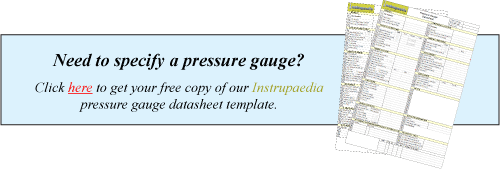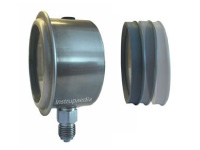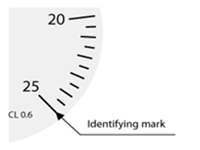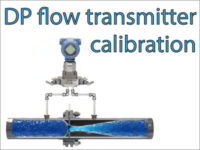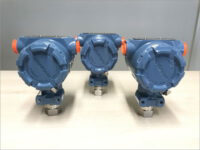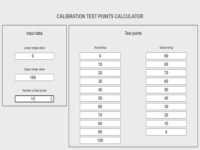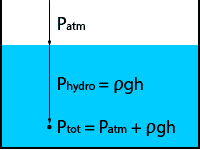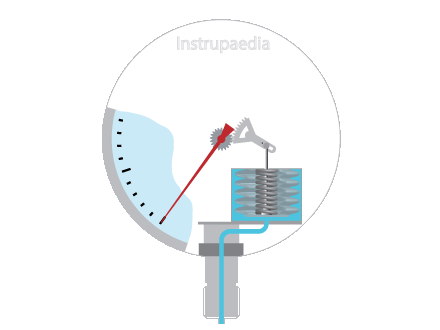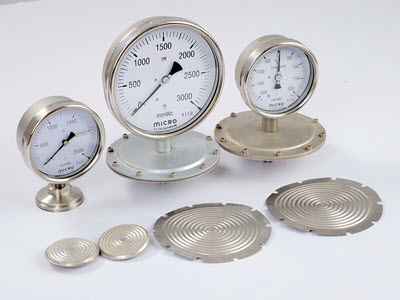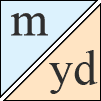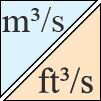Capsule pressure gauge
Pressure gauge working principle and properties
17 April 2017
Capsule pressure gauge working principle
The sensing element of a capsule pressure gauge consists of two corrugated diaphragms welded together at their periphery to form a capsule.
The pressure to be measured is introduced into the capsule via an opening in the center of the first diaphragm. The center of the second diaphragm is connected to the transmission mechanism so that the deflection of the measuring element can be transmitted to the pointer.
When the pressure rises inside the capsule, both diaphragms will slightly deform. By making use of two diaphragms, the total deflection of the measuring
In the pressure gauge animation below, the pressure is going in and out of the capsule, turning the pointer to the right and back to the left.
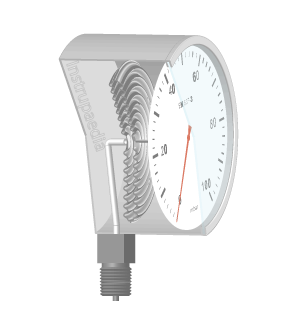
“Check out other pressure gauge animations:”
The capsule
As you can see in the illustrations below, there are two types of capsules: convex and nested. A convex capsule is formed by attaching two convex diaphragms opposite to each other. A nested capsule consists of a convex and a concave diaphragm, also secured to one another along their periphery.
If the process pressure is applied along the exterior of the capsule, nested capsules have the advantage of being more resistant to overpressures.
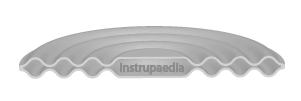
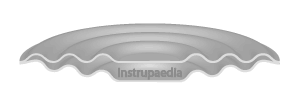
For the measurement of very small pressure differences, the deflection of a single capsule may be too small. Therefore, multiple capsules can be stacked on top of each other until sufficient displacement is obtained to move the pointer across the full scale. These stacks can be built with either convex or nested diaphragms.
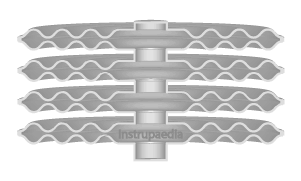
Properties of the capsule gauge
With flat diaphragms, only very small deflections can be achieved since the elastic limit is reached quickly. Therefore, diaphragms are usually corrugated. These corrugations permit a larger deflection of the diaphragm before the elastic limit is reached.
A capsule having a diameter of 50mm (2 inches), consisting of two corrugated diaphragms which are welded to each other, can achieve a deflection of 1.5mm (0.06in).
The magnitude of the deflection depends also on the diameter of the diaphragm. The fact is that the deflection of a diaphragm is proportional to the fourth power of
For flat, circular diaphragms which are clamped along their circumference, the deflection as a function of the radius can be calculated using the equation below.
This is a simplified formula that is only valid for small deflections of the diaphragm, in other words, where the ratio between the deflection of the diaphragm and the pressure applied to the diaphragm is linear. The term from the equation which represents the non-linear deflection has been neglected.

|
|||
| Where: | δ | = | deflection of the diaphragm |
| r | = | radial position | |
| R | = | radius of the diaphragm | |
| D | = | material stiffness of the diaphragm | |
| P | = | pressure applied to the diaphragm | |
| δc | = | centre deflection of the diaphragm | |

The material stiffness of the diaphragm (D) can be found using the following formula:

|
|||
| Where: | E | = | Young’s modulus of elasticity |
| t | = | thickness of the diaphragm | |
| ν | = | Poisson’s ratio | |
For corrugated diaphragms, the equation will be a lot more complicated since it is necessary to take into account the number and the shape of the corrugations, as well as possibly a flat part in the middle of the diaphragm.
A corrugated zone ensures that the radial stress in the diaphragm is reduced by a factor of 1000 to 10000, allows for a reduction of the influence of temperature fluctuations by at least a factor of 120, and reduces the influence of welding stresses along the periphery of the diaphragm.
Because the capsule is made up of two diaphragms each having its own deflection, the sensitivity will be twice as large as that of the diaphragm pressure gauge. The sensitivity is also dependent on the diameter of the capsule. This can vary between 25mm (1 inch) and 150mm (6 inches). The larger the diameter, the greater the sensitivity.
The deflection of a diaphragm can transfer large forces. As a result, it becomes possible to drive a transmission mechanism with a large ratio. It is therefore perfectly possible, with the small deflection of a capsule, to move the pointer across the full scale. Even a small pressure acting on a diaphragm with a large diameter can generate sufficient force to drive the transmission mechanism.
Applications with capsules
Since the pressure chamber of a capsule is not self-draining, it cannot be used for liquids. Capsules are therefore only used for the measurement of gas pressures.
The ability to measure low pressures with diaphragms, along with the property of the double sensitivity of a capsule, ensures that capsules are the ideal sensors for use in a barometer.
In order to create more deflection and more sensitivity, capsules can be stacked on top of each other. A barometer will usually contain 2 to 5 capsules stacked on each other depending on the quality of the device.
Multiple capsules are required because the atmospheric pressure varies little, namely, only between 920 and 1050mbar. The small difference between the minimum and the maximum air pressure is sufficient for the stacked capsules to drive the pointer.
The picture below shows the inside of a barometer with two stacked capsules. Each capsule is evacuated and hermetically sealed. The air pressure acts on the outside of the capsules. To prevent the capsules from collapsing under increasing pressure, a spring is anchored on a bridge and attached to the top

Photo by Gernek / CC BY-SA 3.0
Measuring range of capsule pressure gauges
Capsule pressure gauges are suitable for the measurement of very low negative and positive pressures ranging from 0 – 0.5 mbar to 0-1000 mbar with accuracy classes of 0.1 to 2.5. They can measure both relative and absolute as well as differential pressure.
Absolute pressure sensors
In absolute pressure sensors, the pressure chamber of the capsule is evacuated and hermetically sealed.
The capsule is mounted in a sealed housing. The process pressure is then introduced into the sealed housing through a process connection and applied to the exterior of the capsule.
Since the process pressure is compared to a nearly perfect vacuum inside the capsule, we will be measuring absolute pressure.
The link, which is fixed to the capsule, is passed through the wall of the housing towards the indicator by means of an almost frictionless bellows. The bellows ensure that the pressure in the housing will not leak along the link.
The capsules are designed to bottom on each other in case of overpressure in order to prevent damage.
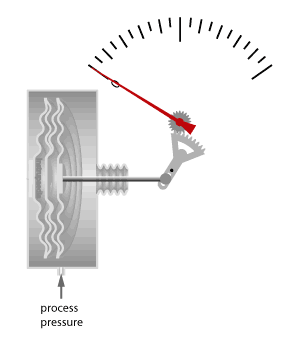
Relative pressure sensors
For the measurement of relative pressures, the process pressure is applied to the inside of the capsule. The capsule thus has a process connection in the middle of a diaphragm through which the process pressure is introduced.
The reference pressure, being the atmospheric pressure, is on the exterior of the capsule.
The measurement of relative pressure can be done with one or multiple capsules.
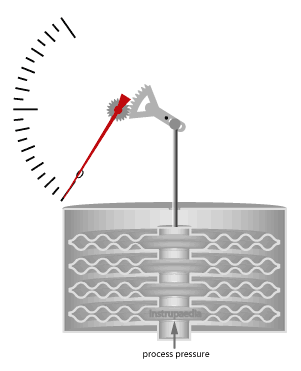
Differential pressure sensors
If the above relative pressure measurement is provided with a second connection and the enclosure at the height of the link is sealed with a bellows, two different pressures can be compared with each other. The resulting pressure, which is measured by the capsules, is the differential pressure of the two process pressures.
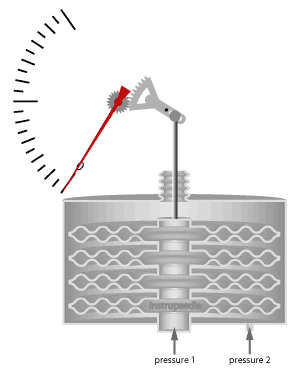
Datasheet template
An easy configurable Excel template is available for specifying capsule pressure gauges. This pressure gauge datasheet is designed to define capsule pressure gauges for all kinds of applications.
Datasheet templates for other types of instruments can be found in the datasheet library.
Related topics
Leave a Comment
Your email address will not be published. Fields marked with * are required.


